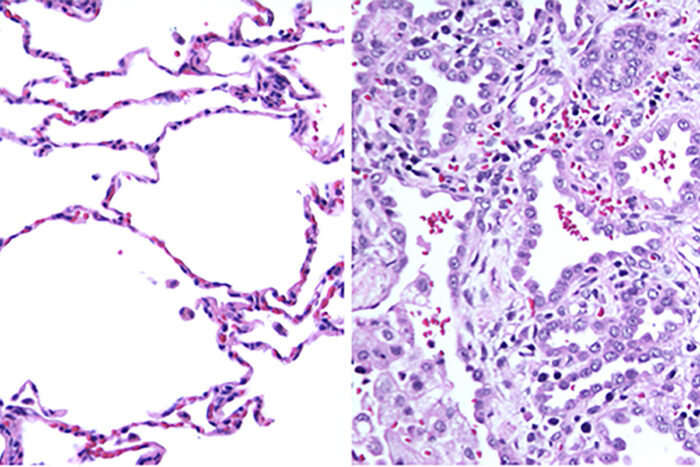A medical mystery was solved by a cross-disciplinary team. The genetic cause of a rare, undiagnosed lung disease was identified. The patient was a 2-year-old child, seemingly healthy at birth but succumbed to interstitial lung disease.
On the left is normal lung tissue showing air sacs with thin cell layers for the exchange of oxygen and carbon dioxide. On the right is the patient’s lung tissue.
The research, conducted as part of the National Institutes of Health’s (NIH) Undiagnosed Diseases Network, demonstrates, among other benefits, how an interdisciplinary team of researchers can work together to solve medical mysteries. The researchers were presented with the case of a young child with interstitial lung disease of unknown cause. The child later died of the disease.
The researchers analyzed the child’s DNA code as well as the DNA code of both parents. A team of bioinformatics specialists narrowed down the initial long list of DNA code changes or genetic variants they identified — many of which are harmless — to a smaller list of possible culprits. The lung tissue from the child had evidence of a problem with surfactant in the lungs. But this child did not have any genetic variants in the code of the surfactant protein genes.
Rather, the researchers found a variant in a gene that makes a protein called RAB5B that turns out to be part of the cellular machinery that processes the surfactant proteins. They showed that the RAB5B protein plays a vital role in packaging the surfactants into vesicles and moving them to their proper locations. In this case, the genetic variant did not simply prevent the protein from working — the genetic variant caused the protein to be actively harmful.
Neither of the child’s parents had the genetic abnormality, indicating that the new variant arose during embryonic development. While the diagnosis was not able to help the patient in this case, knowledge of the underlying cause allowed the parents to know that the genetic variant was not inherited and there would be a very low chance of future children having the same disease.
